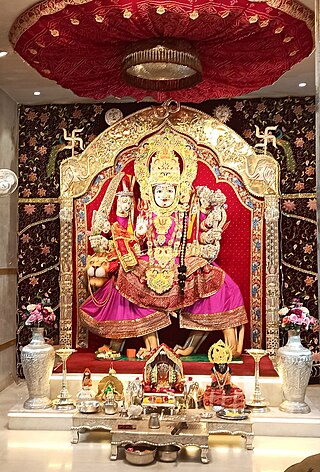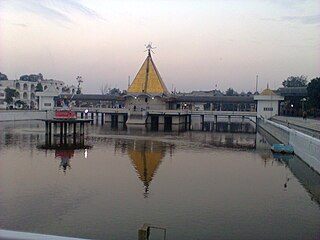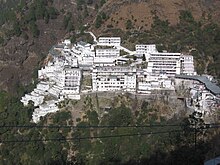
Bhavānī is an epithet associated with Adi Shakti (Durga). Bhavani translates to "giver of life," meaning the power of nature or the source of creative energy. She is considered to be a nurturing mother figure who provides for her devotees and also plays the role of dispensing justice by killing evil Asuras.

Katra is a city and Tehsil in the Reasi district of the Indian union territory of Jammu and Kashmir, situated at the foot of the Trikuta Mountains, where the shrine of Vaishno Devi is located. Katra is located 24 km from the town of Reasi, 42 km (26 mi) from the city of Jammu and around 685 km (426 mi) north of the national capital New Delhi and is the base for pilgrims visiting the Mata Vaishno Devi Temple.

The Shakti Pithas or the Shakti Peethas are significant shrines and pilgrimage destinations in Shaktism, the goddess-centric denomination in Hinduism. The shrines are dedicated to various forms of Adi Shakti. Various Puranas such as Srimad Devi Bhagavatam state the existence of a varying number of 51, 52, 64 and 108 Shakti Pithas of which 18 are named as Astadasha Maha (major) in medieval Hindu texts.
Trikuta is a three-peaked mountain in Hindu mythology. It is one of the twenty mountains surrounding Maha Meru the home of Brahma. The height is said in the Bhagavata Purana to be 10,000 yojanas, and the three peaks are iron, silver and gold. The mountain is believed to be the second home of the divine goddess Durga. She was created with the power of the three goddesses to end evil; hence, the mountain is called Trikuta.

Saptashrungi or Saptashringi is a site of Hindu pilgrimage situated 60 kilometres (37 mi) from Nashik in Indian state of Maharashtra. According to Hindu traditions, the goddess Saptashrungi Nivasini dwells within the seven mountain peaks. It is located in Nanduri, Kalwan taluka, a small village near Nashik in India. The Marathas and some Hindu tribes worship the goddess from a long time and some worship as their kuldaivat. There are 510 steps to climb the gad. Devotees visit this place in large numbers every day. The temple is also known popularly as one of the "three and half Shakti Peethas" of Maharashtra. The temple is also one among the 51 Shakti Peethas located on the Indian subcontinent and is a location where one of Sati's limbs, her right arm is reported to have fallen. Its half shaktipeeth among three and half shaktipeeth of Maharashtra.

A kuladevata, also known as a kuladaivaṃ, is an ancestral tutelary deity in Hinduism and Jainism.

Chintpurni is a small town in the Una district of Himachal Pradesh about 40 km north of Una, not far from the border with the Indian state of Punjab. The elevation is about 977 meters. It is home to the Maa Chintpurni Temple which is a major pilgrimage site as one of the Shakti Peethas in India. The Hindu genealogy registers at Chintpurni, Himachal Pradesh are kept here. North of Chintpurni are the western Himalayas. Chintpurni lies within the much lower Shiwalik range.

In Hinduism, the yatra (pilgrimage) to the tirthas has special significance for earning the punya needed to attain the moksha (salvation) by performing the darśana, the parikrama (circumambulation), the yajna, the Dhyana, the puja (worship), the prarthana, the dakshina, the seva, the bhandara, etc. These sacred places are usually located on the banks of sacred waters, such as sacred rivers or their tributaries, the kundas, the ghats, or the stepwells, or the temple tanks.

The Mangla Gauri temple in Shakti Peetham, Gaya, Bihar, India has been mentioned in Padma Purana, Vayu Purana and Agni Purana and Devi Bhagvata Purana and Markandeya Purana in other scriptures and tantric works. This temple is among the eighteen maha shaktipeeth. The present temple dates back to the 15th century. The shrine is dedicated to Sati or the Mother Goddess in the predominantly Vaishnavite pilgrimage center of Gaya. Mangalagauri is worshipped as the Goddess of benevolence. This temple constitutes a Shakti Peeth — where it is believed that a part of the body - breast of Mata Sati fell according to scriptures of extremely ancient Hindu divine history. Here Sati is worshipped in the form of a breast, a symbol of nourishment. It is believed that whoever comes to Maa Durga with his wishes and prayers, returns successfully with all of prayers and wishes come true.

The Biraja Temple, or Birija Kshetra, is a historic Hindu temple located in Jajpur, Odisha, India. The present temple was built during the 13th century. The principal idol is Devi Durga, who is worshipped as Viraja (Girija), and the temple gave Jajpur the nicknames "Viraja Kshetra" and "Biraja Peetha". The Durga idol has two hands (dwibhuja), spearing the chest of Mahishasura with one hand and pulling his tail with the other. One of her feet is on a lion, and the other is on Mahishasura's chest. Mahishasura is depicted as a water buffalo. The idol's crown features Ganesha, a crescent moon and a lingam. The temple covers a large area, and has several shrines to Shiva and other deities. According to the Skanda Purana it cleanses pilgrims, and it is called the Viraja or the Biraja kshetra. Jajpur is believed to have about one crore of Shiva lingams.

Yogamaya, also venerated as Vindhyavasini, Mahamaya, and Ekanamsha, is a Hindu goddess.
In religion and spirituality, a pilgrimage is a very long journey or search of great moral significance. Sometimes, it is a journey to a sacred area or shrine of importance to innate faith. Members of every major religion participate in pilgrimages. A person who makes such a journey is called a pilgrim.

Bhairav or Bhairavnath was a disciple of Gorakhnath, whose guru was the Matsyendranath. He was considered to have control over all tantrik siddhis and had grown arrogant of his power. He went after Vaishno Devi, considering her to be a little girl. It was only when mata Vaishno Devi took the form of [[Kal i]] and behead Bhairav and in last he realized her true form and asked for forgiveness. In his dying moments, Bhairav pleaded for forgiveness. The Goddess knew that Bhairav's main intention in attacking her was to achieve his salvation. She not only granted Bhairav liberation from the cycle of reincarnation, but also granted him a boon, whereby every devotee, in order to ensure completion of the pilgrimage of Vaishno Devi, shall also have to visit Bhairav Nath's temple near the Holy cave after having the darshan of the Goddess.
Vaishnodevi Temple at Rourkela is a replica of the original Temple of Vaishnodevi of Jammu and is situated on the top of the Durgapur Hill facing towards Rourkela Steel Plant. Bhairabanath Temple is situated near Vaishodevi Temple on the hill.

Devi Talab Mandir is a Hindu Mandir located in Jalandhar, Punjab, India. The temple is devoted to Goddess Durga and is visited by thousands of pilgrims every year. It is regarded as one of the 51 Shakti Pithas in India.
The Banganga is a river of northern India. It is an important tributary of the Chenab River. It flows through Katra, Jammu and Kashmir. The river originates from the southern slope of the Shivalik range of the Himalayas. It's an important stop for Hindu devotees on the ‘’’Vaishno Devi’’’ pilgrimage, where many bathe before continuing their journey.

Jag Janani Maa Vaishno Devi – Kahani Mata Rani Ki, is an Indian mythological television series, which premiered on 30 September 2019 on Star Bharat. It is based on the life of Goddess Vaishno Devi. The series is produced by Rashmi Sharma and Pawan Kumar Marut under Rashmi Sharma Telefilms. The show aired its last episode on 2 October 2020.

Vaishno Devi Temple, also known as the Shri Mata Vaishno Devi Temple and Vaishno Devi Bhavan, is a Hindu mandir (temple) located in Katra, Jammu and Kashmir, dedicated to Vaishno Devi, a manifestation of Durga. It is located on the Trikuta mountain at 5,000 feet elevation. The Shakti tradition considers it to be a Shakti Pitha. The temple is governed by the Shri Mata Vaishno Devi Shrine Board (SMVDSB) and has been chaired by the Governor of Jammu and Kashmir since August 1986.
Vaishno Devi is a Hindu goddess. It may also refers to:
















